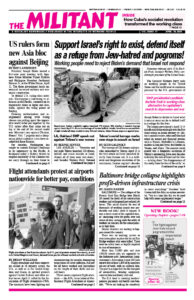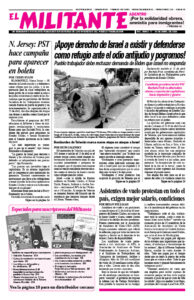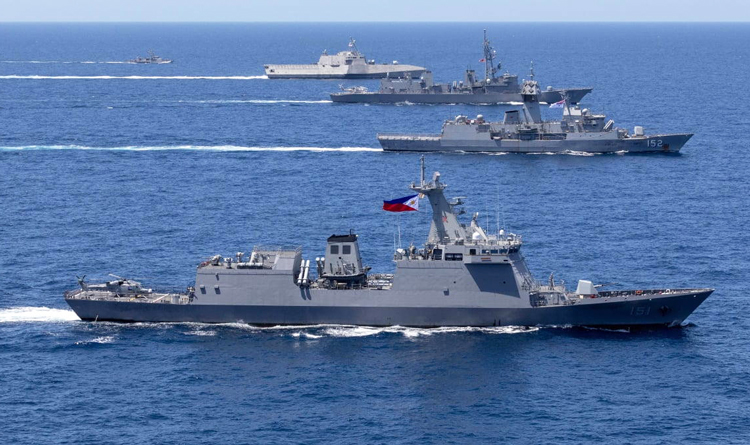President Joseph Biden hosted a first-ever joint meeting with Japanese Prime Minister Fumio Kishida and Philippine President Ferdinand Marcos Jr., at the White House, April 11. The three government heads announced increased military and economic cooperation.
To defend U.S. ruling-class interests, Washington is bolstering its alliances in the Pacific, centered on its imperialist allies in Japan and Australia, against the rising power of Beijing.
Growing militarization and realignments among rival ruling classes are pulling apart the imperialist world order put together by the U.S. rulers after they came out on top at the end of the second world war. Moscow’s war against Ukraine, Hamas’ Oct. 7 pogrom and a sharpening global capitalist crisis have accelerated these fissures.
For decades, Washington has sought to contain Beijing’s challenge to its supremacy in the Pacific. A flashpoint today is Biden’s threats to respond militarily if the Chinese rulers carry through on their threat to invade Taiwan.
Biden, Kishida and Marcos jointly denounced Beijing’s “dangerous and aggressive behavior” and announced plans for combined naval patrols. Biden reiterated that “any attack on Philippine aircraft, vessels or armed forces in the South China Sea would invoke our mutual defense treaty.” The U.S. rulers deploy 54,000 troops in Japan, 24,100 in South Korea, 2,243 in Australia and more across the region.
Kishida denounced Beijing as the “greatest strategic challenge” to the Japanese rulers’ interests. This is behind Tokyo’s sharp shift toward rearmament and intervention in the region after decades of reliance on Washington under a U.S.-imposed “pacifist” constitution from its 1945-1952 occupation.
Japan’s rulers are engaged in a major expansion of their military forces, becoming the world’s third-biggest military spender after the U.S. and China. Tokyo is developing long-range missiles capable of reaching targets in China.
At the summit the three government heads also announced a project to expand infrastructure in the Philippines connecting four areas — Manila, Batangas, Subic Bay and Clark. The latter two are sites of former U.S. bases. U.S. and Japanese capital will invest in railways, the modernization of ports and semiconductor supply chains. The plan seeks to counter the Chinese rulers’ Belt and Road Initiative, which extends loans and infrastructure projects around the world.
Four days before the Washington summit, the first-ever joint naval and air exercises in the South China Sea were held by the armed forces of the three governments along with that of Australia. Beijing said its forces would conduct their own maneuvers elsewhere in the waterway.
Days later a U.S. carrier strike force joined Japanese and South Korean warships for drills in the East China Sea April 10-12.
For their part, Chinese Foreign Minister Wang Yi and his Russian counterpart Sergei Lavrov met in Beijing April 9, pledging to work more closely together against Washington and its allies.
The Chinese government asserts ownership of some 90% of the resource-rich South China Sea. The governments of Taiwan, Vietnam, Malaysia, Brunei, Indonesia and the Philippines also have overlapping rival claims. Beijing has built up and fortified various islets there as military outposts since it brushed aside a 2016 Hague arbitration court ruling against its claims.
About one-third of seaborne world trade each year passes through the South China Sea. Two-thirds of China’s maritime trade, 42% of Japan’s and much of Taiwan’s and South Korea’s shipping pass through the waterway.
Washington has long considered control of the Pacific as one of its central prizes coming out of its victory in World War II.
Frictions grow in South China Sea
Since Marcos’ 2022 election, the Philippine rulers have deepened military and other ties with Washington, amid growing frictions with Beijing. This reverses the course of the previous president, Rodrigo Duterte, who distanced the Philippine rulers from Washington, the former colonial power. Manila, like other smaller capitalist powers, is forced to try to maneuver between Washington and Beijing.
In March, China’s coast guard ships rammed and fired water cannons at Philippine vessels taking supplies to Second Thomas Shoal in the South China Sea. The reef, called Renai Jiao by China, is claimed by both governments. Another disputed reef nearby, Scarborough Shoal, was wrested from Philippine control by Beijing in 2012. Both shoals are within Manila’s proclaimed economic zone, in what it calls the West Philippine Sea.
Beijing’s coast guard ships blocked two of Manila’s research vessels April 13 only 40 miles from the Philippine coastline. It has similarly harassed survey vessels from Vietnam and Malaysia.
The Vietnamese government is also seeking ways to counter the Chinese rulers’ expansionist course, raising its formal ties with Washington to a “comprehensive strategic partnership” last year.
Tokyo has signed a reciprocal troop access agreement with Manila, following similar deals agreed with Washington and the Australian government. A year ago, Manila allowed U.S. forces access to four more bases in the Philippines.
Biden and Kishida announced April 10 that Canberra would be included in three-way cooperation on a new air and missile defense system.
Washington, London and Canberra want to include Tokyo in the part of their AUKUS alliance that covers joint development of advanced military technology. The pact will equip Australia’s rulers with long-range nuclear-powered and conventionally armed submarines. Canberra recently unveiled plans to more than double the size of its navy.
Each of these steps underscores the instability afflicting capitalist powers across the region and signals the threat to working people of more military conflicts and wars to come.



